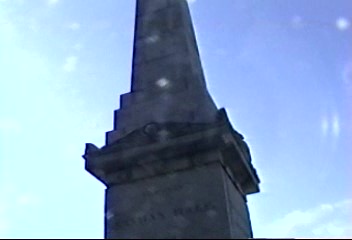Our second day in Connecticut was beautiful, with a clear sky and mild fall temperatures, the perfect day for seeing foliage. I decided to spend the day in the northeastern corner of the state, sometimes called the Quiet Corner because its smaller population means that pictures of the electrical grid usage from Boston through Philadephia shows this corner as dark in a sea of electrical usage. It was actually a day of mishaps in navigating because I wandered around on country roads, at one point getting lost enough that I wound up in Massachusetts. So Tamu and I saw a lot of lovely foliage but we did not get a chance to hike anywhere.

My first stop was at the Nathan Hale Homestead in Coventry. It took some doing to find it, and when I got there, it was not clear if it was open or not, despite the presence of cars nearby. The grounds had a corn maize and I considered taking Tamu for a walk in it, but eventually, the Homestead opened its doors to me and I toured it instead while Tamu waited mournfully in the car. Nathan Hale was a Revolutionary War hero who was hanged when the Redcoats caught him spying for the colonies. The homestead was built by his father from the remains of their smaller house. Hale attended Yale, taught in East Haddam and New London, then volunteered for a Connecticut regiment during the Revolution. He was caught and hanged in September 1776 about a week before he was supposed to meet with George Washington. Very little documentation remains about how he was betrayed, but he is credited as saying, “I regret that I have but one life to lose for my country” before he was hanged on Manhattan. His body was then discarded there, so he is not interred locally. Yale has a prominent statue to him on the campus, and a copy of it was erected at CIA Headquarters.

Locally, he was not valorized as a hero immediately because spying was held in little esteem. By the 1830’s, the town wanted to honor him with a monument and the Hale family opposed it because war monuments and calling attention to him was considered unseemly. In the end, the town won and one of the first war memorials in the US was built at the local cemetery across Wangumbaug Lake from the Hale Homestead, which remained in the family until 1914. I walked the cemetery grounds among graves dating to the 18th century.

From there, I headed to the Prudence Crandall Museum in Canterbury. I was on smaller country highways most of the day and was discovering that it was easy to get lost or stuck in traffic on roads not built for the large car populations. Although I had never heard of her, like Hale, Prudence Crandall is a Connecticut state hero. In 1831, she established the Canterbury Female Boarding School, a posh finishing school for girls. She was a Quaker, and in 1833, she admitted a local African-American student named Sarah Harris. Parents of other students threatened to remove their students to destroy Crandall’s livelihood, so she filled the empty spaces with other local African American girls. This was so unpopular that the town sponsored a state law to prevent Connecticut schools from educating black students from outside the state. That law was overturned, at which point a mob gathered to physically destroy Crandall’s school. As a result, she moved from Connecticut, first to Illinois and then to Kansas. She did challenge the legal effort to shut her school down arguing that, if Blacks were US citizens, they could not be denied access to education that was available to Whites. Her legal battle became the subject of two Supreme Court cases, including Brown v. Board of Education of Topeka, KS, which overturned segregation in schools in 1954. After the Civil War, Connecticut officially recognized Crandall’s work. She was still alive in KS at that time. Unfortunately, I got to the museum about five minutes after it closed, so I did not get to tour it, but Tamu had a great walk about in the autumn leaves.

There were a number of prestigious boarding schools in this quiet corner, but the area also closed early. I stopped for soup and sandwich in Pomfret at a place that had been highly recommended, but felt unwelcome. So I pressed on to find a place for Tamu and I to hike and, after a short detour to Massachusetts, we turned ourselves around and encountered Bigelow’s Hallow State Park. It made for a gorgeous drive but was getting too dark for a long hike. The foliage was gorgeous with the stone fences of New England. It was a peaceful end to a leisurely day.

